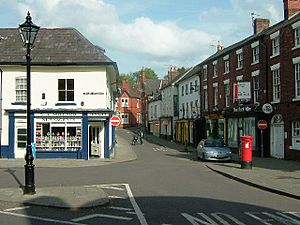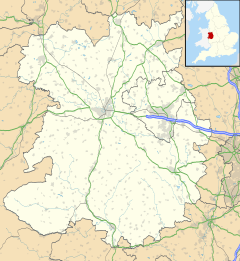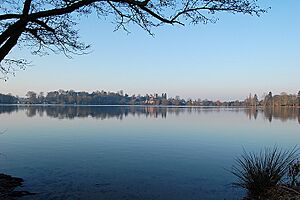Ellesmere, Shropshire facts for kids
Quick facts for kids Ellesmere |
|
|---|---|
 Ellesmere town centre |
|
| Population | 3,835 (2011) |
| OS grid reference | SJ398349 |
| Civil parish |
|
| Unitary authority |
|
| Ceremonial county | |
| Region | |
| Country | England |
| Sovereign state | United Kingdom |
| Post town | ELLESMERE |
| Postcode district | SY12 |
| Dialling code | 01691 |
| Police | West Mercia |
| Fire | Shropshire |
| Ambulance | West Midlands |
| EU Parliament | West Midlands |
| UK Parliament |
|
Ellesmere (pronounced ELZ-meer) is a town in Shropshire, England. It is located close to the border with Wales. Nearby towns include Oswestry and Whitchurch, and the Welsh city of Wrexham. Ellesmere is well-known for being near several large natural lakes called 'meres'.
Contents
History of Ellesmere
Ellesmere Castle and Early Rulers
Ellesmere Castle was likely built around the 11th century. It was a "motte-and-bailey" castle, which means it had a raised earth mound (motte) with a wooden or stone tower, and a walled courtyard (bailey). It was probably built by Roger de Montgomerie, 1st Earl of Shrewsbury, or his son, Roger the Poitevin. The castle stood on a hill called Castlefields, looking over the Mere. Today, only the earth mounds remain. The top of the motte is now used as a bowling green, offering a great view.
In 1114, King Henry I gave Ellesmere to William Peverel. It was part of a larger area called the Maelor. This area included Overton and Whittington at that time. William Peverel's family kept Ellesmere until the late 1140s. Then, Madog ap Maredudd of Powys took control, probably by force.
After Madog died in 1160, Ellesmere became part of King Henry II's lands. In 1177, King Henry II gave Ellesmere to Dafydd ab Owain Gwynedd. Dafydd was the ruler of Gwynedd in Wales. He had married Emme of Anjou, who was King Henry's half-sister. Dafydd remained the Lord of Ellesmere until he died in 1203.
Ellesmere and Welsh Princes
In 1205, Llywelyn the Great, a powerful Welsh prince, married Joan, Lady of Wales. Joan was the daughter of King John. Ellesmere was given to them as a wedding gift. Llywelyn kept control of Ellesmere until he died in 1240. In 1241, King Henry III ordered that the wooden castle at Ellesmere be repaired.
Later, the lordship of Ellesmere seems to have passed to Llywelyn ap Gruffudd or his brother Dafydd ap Gruffydd. They were the last native Princes of Wales. In March 1282, royal troops from Chester captured the castle.
Later History and Important People
In 1287, Oliver Ingham was born in Ellesmere. He became an important English commander. In 1321, he was given charge of Ellesmere Castle.
By 1294, a religious house called Dolgynwal joined with Halston. Halston then became the main center for all Knights Hospitaller lands in North Wales. The Knights Hospitaller were a Christian military order.
In 1435, Griffin Kynaston, a local official, gave evidence in Shrewsbury. His fourth son, Sir Roger Kynaston, became an important officer in Merioneth and Shropshire. Roger's son, Humphrey Kynaston, was declared an outlaw in 1491 by King Henry VII. He hid in a cave at Nesscliffe Rock, which is still called "Kynaston's Cave." He was pardoned in 1493.
In 1535, Ellesmere, which was once a special border area, became part of Shropshire.
Francis Egerton, 1st Earl of Ellesmere, was born in London in 1800. He loved art and bought a famous portrait of William Shakespeare in 1848. Ellesmere Island in Canada is named after him.
In 1891, Ellesmere had a population of 5507 people. In 1894, the area was divided into "Ellesmere Urban" (the town) and "Ellesmere Rural" (the countryside).
The Cremorne Gardens in Ellesmere were once home to a tannery (a place where animal hides are made into leather). These gardens were given to the people of Ellesmere by Peregrine Cust, 6th Baron Brownlow.
Commerce and Trade
Market Town and Canal
The area around Ellesmere has always been good for dairy farming. Ellesmere was a busy market town. It held several fairs each year where dairy products and livestock were sold. In 1752, a new turnpike road was built from Shrewsbury to Wrexham, passing through Ellesmere. Turnpike roads used tolls to pay for road maintenance, which made transport much better. Later, more turnpike roads connected Ellesmere to Whitchurch and Oswestry.
Trade grew even more from 1805 when Ellesmere got its canal connection. The canal linked Ellesmere to Ellesmere Port and then to the port of Liverpool. From Liverpool, ships sailed all over the world. In 1806, a new July Fair was added. This fair sold "horned cattle, horses, pigs, sheep, leather, grain, butter, cheese, wool, bacon, hops, and every other produce of land." The canal made it easy to bring in heavy materials like timber, iron, and coal. This also allowed a gas works to be built nearby. An iron foundry, Bridgewater Foundry, was at the end of the canal. It made farm tools and iron parts for the canal itself.
Railway and Cheese Factory
In 1863, Ellesmere got its first railway line from Whitchurch. By July 1864, the line was extended to Oswestry. In 1895, a line opened from Ellesmere to Wrexham. The station had a large goods yard and a special siding for livestock. A new cattle market opened next to the cattle dock in December 1869.
The Ellesmere area was especially known for making cheese. A lot of Cheshire cheese was made in North Shropshire. In 1909, the Bridgewater Foundry closed. Later, a cheese factory was built in its place. By the 1930s, this factory was the biggest employer in Ellesmere. The cheese factory continued to be a major employer until it closed in January 1987. This closure meant 329 people lost their jobs.
Geography of Ellesmere
Ellesmere town is located right next to a large lake called Ellesmere, also known as 'the Mere'. This is one of the biggest natural lakes in England outside the Lake District. It is one of nine "glacial meres" in the area. Glacial meres are lakes formed when a large block of ice melted after the last ice age, leaving a depression that filled with water. Unlike lakes in the Lake District, these meres do not have rivers flowing into them to keep their water levels up.
In 1812, an artificial island was built in the Mere. Soil dug from the gardens at Ellesmere House was used to create it. This island was later named Moscow Island. This was because Napoleon was forced to retreat from Moscow that same year. The Mere has a visitors' center and is a popular spot for birdwatchers. Many people visit to see grey herons nesting there. There are eight other meres nearby: Blakemere, Colemere, Crosemere, Kettlemere, Newtonmere, Whitemere, Sweatmere, and Hanmer Mere.
The town itself is a civil parish called Ellesmere Urban. The countryside around it is a separate parish called Ellesmere Rural.
Transport in Ellesmere
Roads and Canals
The A495 and A528 roads meet in Ellesmere. The A528 goes south-southeast for about 15 miles to Shrewsbury, the county town.
The town is also next to the Llangollen Canal. A short branch of the canal goes right into the town center. The canal eventually ends near Llangollen at Llantysilio. It passes through a World Heritage Site that includes the Chirk Aqueduct and Pontcysyllte Aqueduct. The canal was originally known as the Ellesmere Canal. Thomas Telford was the main director of its construction. Work on the canal lasted from 1793 to 1805. The goal was to connect Chester and the River Mersey at Ellesmere Port (which is named after Ellesmere) with Shrewsbury. However, it never reached Shrewsbury due to rising costs and other canal routes being completed. During its construction, Thomas Telford lived in a house next to the canal in Ellesmere, which is still there today.
Railways and Buses
Ellesmere no longer has a railway station. It was once on the main line of the Cambrian Railways. However, the section from Whitchurch to Welshpool, passing through Ellesmere, closed in 1965. Ellesmere was also the end point of a branch line to Wrexham (Central). This line closed in 1962. The old Ellesmere railway station building is still standing, but it is no longer used. The closest active train station to Ellesmere is Gobowen for Oswestry, which is about 8 miles away.
Bus services in Ellesmere are run by different companies. Here are some of the main routes:
- Service 53 goes to Oswestry via Gobowen. It runs every 40 minutes from Monday to Saturday.
- Service 205 is a local town service that runs on Tuesdays and Fridays.
- Service 449 goes to Oswestry via Welsh Frankton. It runs roughly every hour from Monday to Saturday.
- Service 501 goes to Shrewsbury via Cockshutt and Harmer Hill. It runs roughly every hour.
Landmarks in Ellesmere
- St Mary's Church – This church has Norman origins (meaning it was built around the time of the Norman Conquest). It was mostly rebuilt in 1849 by Sir George Gilbert Scott. It is a Grade I listed building, meaning it is very important historically.
- The Old Town Hall – This is one of Ellesmere's most famous buildings. It was built in 1833 and is a Grade II listed building.
Education in Ellesmere
Ellesmere has two main schools. Ellesmere Primary School is for children aged 4–11. Lakelands Academy is a secondary school for students aged 11–16. It became an academy in 2013. Former students of Lakelands Academy include Luke Preston. There are also other schools nearby, like Welshampton Church of England School.
Just outside the town is Ellesmere College. This is a private boarding school. It was founded in 1884 to educate sons of middle-class families. Today, it is a co-educational school, meaning both boys and girls attend, from ages 7–18.
Media in Ellesmere
Local news and TV shows for Ellesmere come from BBC West Midlands and ITV Central. Radio stations include BBC Radio Shropshire, Hits Radio Black Country & Shropshire, and Greatest Hits Radio Black Country & Shropshire. The local newspapers are The Border Counties Advertizer and the Shropshire Star.
Sport in Ellesmere
Ellesmere has a semi-professional football club called Ellesmere Rangers FC. They play their home games at Beech Grove. They are part of the North West Counties Football League.
The town's cricket club has teams that play in the Shropshire County Cricket league. The first team is in Division One, and the second team is in Division Six.
Twin Cities
Ellesmere is twinned with Diksmuide, a town in Belgium. This means the two towns have a special friendship and often exchange visits.
Notable People from Ellesmere
Many interesting people have connections to Ellesmere:
- Roger de Montgomerie, 1st Earl of Shrewsbury (around 1030–1094) – He was involved in building the castle.
- Dafydd ab Owain Gwynedd (around 1145–1203) – A Welsh prince who was given Ellesmere by King Henry II.
- Joan, Princess of Wales (around 1191–1237) – Daughter of King John, she received Ellesmere as a wedding gift when she married Llywelyn the Great.
- Sir Oliver Ingham (around 1287–1344) – A knight who was given charge of Ellesmere Castle.
- David Holbache (around 1355–1422/23) – A Welsh politician who founded Oswestry School.
- Thomas Telford (1757–1834) – A famous engineer who lived in Ellesmere while building the Llangollen Canal.
- Francis Egerton, 1st Earl of Ellesmere (1800–1857) – A poet and supporter of the arts, after whom Ellesmere Island in Canada is named.
- Edward King (1829-1910) – Later a Bishop, he was tutored in Ellesmere in the 1840s.
- Eglantyne Jebb (1876 in Ellesmere – 1928) – A social reformer who founded the charity Save the Children.
- Dorothy Buxton (1881 in Ellesmere – 1963) – A humanitarian and social activist.
- Peregrine Cust, 6th Baron Brownlow (1899–1978) – He gave the Boathouse, the Mere, and Cremorne Gardens to the people of Ellesmere.
- Owen Paterson (born 1956) – A politician who lives near Ellesmere and was a Member of Parliament for the area.
- David Phillips (1924 in Ellesmere – 1999) – A pioneering scientist who became Baron Phillips of Ellesmere.
- Francis Egerton, 7th Duke of Sutherland (born 1940) – Became the 6th Earl of Ellesmere in 2000.
Sports People
- Harry Adams (1855–1910) – A Welsh international footballer who moved to Ellesmere.
- Robert Topham (1867 in Ellesmere – 1931) – A footballer who played for England twice.
- Arthur Topham (1869 in Ellesmere – 1931) – Robert's brother, also a footballer who played for England once.
- Peter Lee (born 1956 in Ellesmere) – An ice hockey manager and former professional player.
- Luke Preston (born 1976) – A Welsh Judo competitor who grew up nearby.
- Oliver Townend (born 1982) – A British eventing rider who won a gold medal at the 2020 Summer Olympics. He lives in Ellesmere.
See also
 In Spanish: Ellesmere (Shropshire) para niños
In Spanish: Ellesmere (Shropshire) para niños





